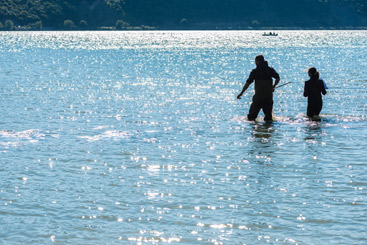Danube Watch 2/2016 - Examining the Danube experience: a case for global commitment
Examining the Danube experience: a case for global commitment
Of the world’s 270 transboundary water bodies, the Danube is the most international, with 19 countries sharing in its catchment. By many accounts, the Danube is seen to demonstrate an example of good practices in regions where joint water management is challenging. The Danube should indeed help to pass on valuable lessons – and if some important limitations are taken into account, it will also benefit in turn.

The ICPDR has links to initiatives outside of the Danube basin that far exceed the global activities of other river basin organisations, which allows the ICPDR to give back to the global community some of the support that the ICPDR enjoyed in the 1990es and 2000s.
© Künzelmann/UFZ
Organised cooperation among countries is almost always a matter of resources – when a country is doing well economically, its commitment to partnering with others is usually higher than in times of hardship. No wonder that we currently see a trend towards decreased international activities as many countries are facing relative decline, especially in the developed world. While in some sectors and some parts of the world local hegemons push to expand their interests via national means, many international organisations struggle to keep their members committed. Transboundary water management is no exception.
A model of good practices. The Danube experience is a popular ‘good practice’ example and the ICPDR as the main cooperation mechanism for countries in the Danube Basin is one of the strongest brands of any river basin organisation. This is seen not only in the strong identification of ICPDR contracting parties with the Commission, but also through third-party endorsements.
The ICPDR has links to initiatives outside the Danube basin that far exceed the global activities of other river basin organisations. Not only is the Secretariat based at one of the UN headquarters, the organisation also acts very globally. For example, the ICPDR won the Thiess International River Prize in 2007; acts as the official partner of the Global Environment Facility’s (GEF) IW:learn project; cooperates closely with international bodies such as the UNECE Water Convention (Helsinki Convention), the German development agency GIZ (see page 8) and the OECD Water Governance Initiative; and is a founding member of the Source-to-Sea platform established by key global players in the international water arena.
Learning from the ICPDR. The design of the organisation has proven to be very successful: a lean structure with a small, professional secretariat that concentrates highly technical and administrative capacities on one hand; on the other, it has national experts in expert groups to ensure that the organisation is firmly anchored in its members who have full control over it. This gives countries a strong sense of ownership, also expressed most importantly by the financing of the organisation through equal membership contributions.
Furthermore, the ICPDR is very technically minded and not constrained by diplomatic protocol; it is also very inclusive as shown by the strong integration of external stakeholders in its every-day work. With this structure as a basis, the ICPDR has evolved over the past 20 years into a body that delivers some of the most advanced river basin and flood risk management products in the world – most significantly the two recent management plans.
Of course, using the ICPDR as a model for other regions does have its limitations. The role as a cooperation mechanism at the intersection between EU and non-EU member states with the framework of EU directives is unique, and so is the high diversity of countries, economies and societies within the Danube Basin. Many other river basin organisations have broader portfolios than the ICPDR and also deal, for example, with navigation or development issues.
Benefiting from global activities. There is much the ICPDR can learn from other organisations dealing with different circumstances. The field of water scarcity and drought management, for example, is just emerging in Europe, but has been a significant pressure in many other regions for quite some time. In addition, global exposure helps the ICPDR raise its profile and maintain its reputation. This allows actors in the ICPDR family to stay tuned to the newest developments and trends, which is a prerequisite if we want to continue to set standards. It is also an important way to give back to the global community some of the support that the ICPDR enjoyed in the 1990 and 2000s in the form of projects and financial support from the UN GEF, EU and other international donors.
It is through activities in the global network that we get access to resources such as information, grants, and the personal networks of water professionals. Each of these resources is absolutely vital for the entire ICPDR family – delegations, expert and task group members, secretariat staff and observer community – to maintain the highest quality in its work, to continue to define standards and, most importantly, to keep learning continuously. In short: to avoid falling into provincialism. For in the global context, even the world’s most international river basin is a mere puddle if viewed in isolation.







